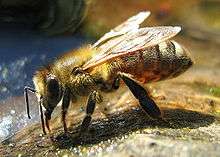Melittology

A bee drinking water
Melittology (from Greek μέλιττα, melitta, "bee"; and -λογία -logia) is a branch of entomology concerning the scientific study of bees. Melittology covers the species found in the clade Anthophila within the superfamily Apoidea, comprising more than 20,000 species,[1] including bumblebees and honey bees.
Subdivisions
- Apiology - (from Latin apis, "bee"; and Ancient Greek -λογία, -logia) is the scientific study of honey bees. Honey bees are often chosen as a study group to answer questions on the evolution of social systems.
- Apidology is a variant spelling of apiology used outside of the Western Hemisphere, primarily in Europe; it is sometimes used interchangeably with melittology.
- Apicology - the study of honey bee ecology.
Melittological societies
Melittologists and apiologists are served by a number of scientific societies, both national and international in scope. Their main role is to encourage the study of bees and apicultural research
- International Bee Research Association
- National Bee Association of New Zealand
- British Beekeepers Association
- German Beekeepers Association
Melittological Journals
- Apidologie
- American Bee Journal
- Journal of Apicultural Research
- Journal of Melittology
List of notable melittologists and apiologists
- Freiderich August Bechly (Fred Bechly), (1835-1916), was a correspondent for the American Bee Journal.
- Charles Butler, (1560-1647), early English beekeeper and researcher.
- Charles Dadant, (1817-1902), Modernized beekeeping.
- Jan Dzierzon, (1811-1906), Discovered parthenogenesis among bees, proposed first sex determining mechanism for any species.
- Savannah Foley, studies genetics and communication over long distances at the University of South Florida, leading a team investigating recent dropping numbers of honey bees.
- Michael S. Engel, (b. 1971), studies honey bee and other bee taxonomy and paleontology at the University of Kansas.
- Karl von Frisch, (1886-1982), Nobel Prize winner, studied honey bee communication.
- Robert A. Holekamp, (1848-1922), Early urban apiculturalist and advocate.
- Jay Hosler, Professor at Juniata College, Author of the award-winning comic Clan Apis.
- Karl Kehrle (aka "Brother Adam") (1898-1996), Benedictine monk, beekeeper, and an authority on bee breeding, developer of the Buckfast bee.
- Warwick Estevam Kerr, (b. 1922), Studies genetics and sex determination in honey bees. Responsible for introduction of Africanized bees to America.
- William Kirby, (1759-1850), Author of the first scientific treatise on English bees.
- L. L. Langstroth, (1810-1895), Modernized American beekeeping.
- Martin Lindauer, (1918-2008), studied communication systems in various species of social bees including stingless bees and honey bees.
- Sir John Lubbock (the 1st Lord and Baron Avebury) (1834–1913), wrote on hymenoptera sense organs.
- Robert E. Page, Jr., Studies population genetics and the evolution of complex social behavior at Arizona State University.[2]
- Petro Prokopovych, (1775–1850), Ukrainian beekeeper, founder of commercial beekeeping.
- Moses Quinby, (1810-1875), Early American commercial beekeeper. Invented modern bee smoker.
- Gene E. Robinson, Studies mechanisms of bee-havior at the University of Illinois.[3]
- Amos Ives Root (1839 – 1923), Innovator in honey harvesting techniques. Published first account of Wright brothers flight in his beekeeping journal.
- Grace Sandhouse[4]
- Justin O. Schmidt, Studies bee nutrition, chemical communication, physiology, ecology and behavior. Created Schmidt Sting Pain Index.
- Thomas D. Seeley, Studies group organization using the honey bee as a model system at Cornell University.[5]
- Robert Evans Snodgrass, (1875-1962), Author of one of the first comprehensive books on honey bee anatomy and physiology.
- Stephen Taber III, (1924-2008), Innovator in the practice of artificial insemination of queen bees for the purpose of developing disease resistant and gentle bee colonies.
- Mark Winston, Studies life history, caste structure, and reproduction in social insects and pheromones of honey bees at Simon Fraser University.[6]
See also
References
- ↑ "Bees - Facts About Bees - Types of Bees - PestWorldforKids.org". pestworldforkids.org. Retrieved 2016-04-26.
- ↑ ASU SoLS Faculty: Robert E. Page
- ↑ University of Illinois - Honey Bee Research Group
- ↑ "Grace Sandhouse Papers". Record Unit 7456. Smithsonian Institution Archives. Retrieved 6 March 2012.
- ↑ Thomas D Seeley
- ↑ Dr. Mark L. Winston
This article is issued from Wikipedia - version of the 10/30/2016. The text is available under the Creative Commons Attribution/Share Alike but additional terms may apply for the media files.